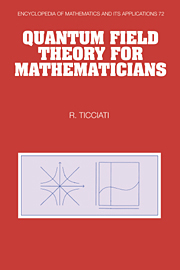Book contents
- Frontmatter
- Contents
- Preface
- Introduction
- 1 Relativistic Quantum Mechanics
- 2 Fock Space, the Scalar Field, and Canonical Quantization
- 3 Symmetries and Conservation Laws
- 4 From Dyson's Formula to Feynman Rules
- 5 Differential Transition Probabilities and Predictions
- 6 Representations of the Lorentz Group
- 7 Two-Component Spinor Fields
- 8 Four-Component Spinor Fields
- 9 Vector Fields and Gauge Invariance
- 10 Reformulating Scattering Theory
- 11 Functional Integral Quantization
- 12 Quantization of Gauge Theories
- 13 Anomalies and Vacua in Gauge Theories
- 14 SU(3) Representation Theory
- 15 The Structure of the Standard Model
- 16 Hadrons, Flavor Symmetry, and Nucleon-Pion Interactions
- 17 Tree-Level Applications of the Standard Model
- 18 Regularization and Renormalization
- 19 Renormalization of QED: Three Primitive Divergences
- 20 Renormalization and Preservation of Symmetries
- 21 The Renormalization Group Equations
- Appendix
- References
- Index
16 - Hadrons, Flavor Symmetry, and Nucleon-Pion Interactions
Published online by Cambridge University Press: 31 October 2009
- Frontmatter
- Contents
- Preface
- Introduction
- 1 Relativistic Quantum Mechanics
- 2 Fock Space, the Scalar Field, and Canonical Quantization
- 3 Symmetries and Conservation Laws
- 4 From Dyson's Formula to Feynman Rules
- 5 Differential Transition Probabilities and Predictions
- 6 Representations of the Lorentz Group
- 7 Two-Component Spinor Fields
- 8 Four-Component Spinor Fields
- 9 Vector Fields and Gauge Invariance
- 10 Reformulating Scattering Theory
- 11 Functional Integral Quantization
- 12 Quantization of Gauge Theories
- 13 Anomalies and Vacua in Gauge Theories
- 14 SU(3) Representation Theory
- 15 The Structure of the Standard Model
- 16 Hadrons, Flavor Symmetry, and Nucleon-Pion Interactions
- 17 Tree-Level Applications of the Standard Model
- 18 Regularization and Renormalization
- 19 Renormalization of QED: Three Primitive Divergences
- 20 Renormalization and Preservation of Symmetries
- 21 The Renormalization Group Equations
- Appendix
- References
- Index
Summary
Connecting the strong interactions to observed particles in preparation for application of the Standard Model to low-energy scattering.
Introduction
In this chapter, we begin the study of hadrons, the strongly interacting particles like neutrons, protons, and pions. The first level of study introduces the hadrons as bound states of quarks; the second level, the nucleon-pion theory of nuclear structure.
The concept of a quark arose from insight into experimental data on strong interactions. First, the data indicated approximate conservation of two quantum numbers, and second, when the known hadrons were plotted with respect to these two quantum numbers, the results resembled SU(3) weight diagrams. Since all SU(3) representations can be obtained as subrepresentations of tensor products of the vector representation and its conjugate, it was therefore natural (though bold) to propose that the vector representation of SU(3) must correspond to the fundamental particles in the theory of hadrons. The basis elements for this representation are the u, d, and s quarks, and the SU(3) in question is the flavor symmetry.
Experiment indicates that there are at least six quarks. These are u, d, c, s, b, and t. Cosmology and the scale of quark confinement require that there are no more than eight quarks; particle data indicates that there are at most six quarks.
- Type
- Chapter
- Information
- Quantum Field Theory for Mathematicians , pp. 480 - 506Publisher: Cambridge University PressPrint publication year: 1999



